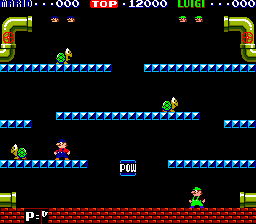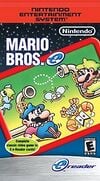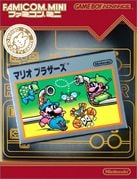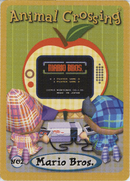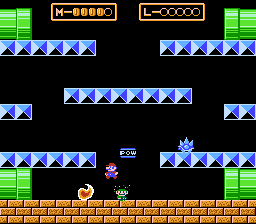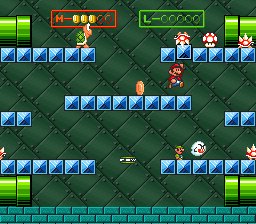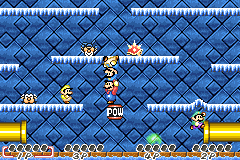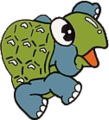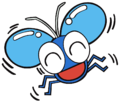Mario Bros. (game)
| It has been suggested that this page be split into Mario Bros. (game), Mario Bros. (Nintendo Entertainment System), Mario Bros. (Atari, Inc), Mario Bros. (Ocean Software), Mario Bros. (Westside Soft House), Mario Bros. (Atari Corporation). (discuss) |
- This article is about the arcade title first released in 1983. For further uses, see Mario Bros.
- Not to be confused with Super Mario Bros.
| Mario Bros. | |||||||||||||
|---|---|---|---|---|---|---|---|---|---|---|---|---|---|
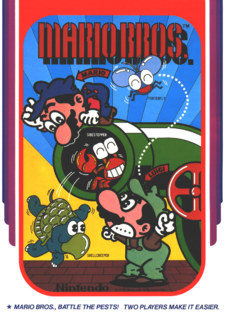 A flyer for the original arcade game For alternate box art, see the related gallery. | |||||||||||||
| Developers | Nintendo R&D1 Intelligent Systems (Famicom/NES port) Atari, Inc. (Atari 2600 and Atari 5200 ports) MISA (PC-8001 port)[1] Choice Software (Amstrad CPC and ZX Spectrum ports) Ocean Software (Commodore 64 port) ITDC (Atari 7800 port) Sculptured Software (Atari 8-bit port) | ||||||||||||
| Publishers | Nintendo Atari, Inc. (Atari 2600 and Atari 5200 ports) Westside Soft House (PC-8001 port) Ocean Software (Amstrad CPC, ZX Spectrum, and Commodore 64 ports) Atari Corporation (Atari 7800 and Atari 8-bit ports) HAMSTER (Arcade Archives) | ||||||||||||
| Platform | Arcade
Family Computer, Nintendo Entertainment System, Atari 2600, Atari 5200, NEC PC-8001, Famicom Box, Nintendo PlayChoice-10, Amstrad CPC, Commodore 64, ZX Spectrum, Atari 7800, Atari 8-bit, Game Boy Advance (e-Reader), Virtual Console (Wii, Wii U, Nintendo 3DS), NES Classic Edition/Nintendo Classic Mini: Family Computer, Nintendo Switch (Arcade Archives), Nintendo Entertainment System - Nintendo Classics
| ||||||||||||
| Release dates | Arcade:
Family Computer:
Nintendo Entertainment System: Atari 2600: Atari 5200: PC-8001: Nintendo PlayChoice-10: Amstrad CPC: Commodore 64: ZX Spectrum: Atari 8-bit: Atari 7800: Game Boy Advance: Virtual Console (Wii): Virtual Console (3DS): Virtual Console (Wii U): NES Classic Edition: Nintendo Switch (Arcade Archives): Nintendo Entertainment System - Nintendo Classics: | ||||||||||||
| Language | English | ||||||||||||
| Genre | Platformer | ||||||||||||
| Ratings |
| ||||||||||||
| Modes | Single player, multiplayer (up to two players simultaneously) | ||||||||||||
| Format | Arcade:
Built-in Famicom:
NES:
Wii: Wii U: Nintendo Switch: Game Boy Advance: Nintendo 3DS: NES Classic Edition:
Built-in
| ||||||||||||
| Cabinet | Upright and cocktail | ||||||||||||
| Input | Arcade: Joystick Atari 2600:
Famicom:
NES:
Wii: Wii U: Nintendo Switch: Game Boy Advance: Nintendo 3DS: Home computer system: NES Classic Edition:
| ||||||||||||
| Serial codes | Famicom: Game Boy Advance: | ||||||||||||
- “Something's gumming up the plumbing! Poor Luigi's in a bind! Giant turtles out to get him! Creepy crabs are right behind! Fighterflies! Jeepers, yipes! They're all coming out of the pipes! Mario, where are you?”
- —Commercial for Atari 2600 and Atari 5200 versions
Mario Bros. is an arcade game developed by Nintendo and released on June 21, 1983.[2] It was also released on the NES under the Arcade Classics Series of games (a version itself later ported to other systems), Atari 2600, Atari 5200, and Atari 7800 as well as a large multitude of home computer systems. This was the first game of the Super Mario franchise to introduce a simultaneous two-player mode, coins, pipes, and POW Blocks. The game is often stated to be the first appearance of Luigi, such as by Nintendo during the Year of Luigi that commemorated his debut, despite the fact that Luigi had actually previously appeared in the Game & Watch game of the same name, though the arcade game was in development first.[citation needed] Beyond featuring Mario and Luigi, the Game & Watch game bears no similarity to the arcade game.
Mario Bros. is also included as a separate minigame, functioning like the original game with updated graphics, in the two-player mode of Super Mario Bros. 3, as well as in Mario & Luigi: Superstar Saga and all four games in the Super Mario Advance series.
Story[edit]
The premise of the game revolves around twin plumbers Mario and Luigi, who are in the sewer system of New York[5][6] (or their house, according to Atari).[7] The sewers are overrun by waves of enemies, which must be defeated for coins.
Gameplay[edit]
The game features a simple stage in which the player plays in an endless game. Much of the gameplay appears to have been inspired by an arcade game named Joust. Enemies come from the pipes on the top and head downwards, where they may enter the pipes again to return to the top. The game features 22 unique phases (although Phase 2 was removed from non-Japanese versions of the game), and after the last phase has been completed, it merely loops the phase order from then on; the screen will still read "Phase 23" onward up to "Phase 98" (99 in Japan). After reaching Phase 98/99, screen text will stop incrementing, though the order of unique phases still loops. The phase counter at the bottom of the screen reads "KO" from Phase 25 onward.
The goal in each phase is to defeat all enemies, which is done by jumping up and hitting the floor below enemies. This flips them, giving the player the chance to kick them away, which is rewarded with 800 points. Enemies that are kicked over in succession quickly enough after the first will award 800 more points, up to 3200 points. The highest score that the game can display is 999,990 points, and scoring any more will overflow the display and make it start counting from 0 again. The POW Block can also be used to flip enemies; however, it can be used only three times. After an enemy is knocked away, a coin (a "wafer" in the Atari 2600 version of the game) appears from one of the pipes, and gives 800 points when collected. When all enemies are defeated, the player continues to the next phase. In later levels, different types of enemies and harming fireballs appear. In Phases 4, 9, and every seventh phase after that (Phase 3 and every fifth phase after that in the NES version), a bonus level appears where all the coins have to be collected in order to get an extra 5,000 points (during the first bonus level) or 8,000 points (during the second bonus level onwards). The time limit of the bonus level at first is 20 seconds, but starting from the second bonus level (third in the NES version), it is reduced to 15 seconds. Excluding the first bonus level, all bonus levels have floors of ice. The POW Block regenerates after the second bonus level and every subsequent bonus level. Unlike the arcade original, upon reaching Phase 100 in the NES version, the screen reads "Phase 0", and completing it will start incrementing the phase counter again as normal.
Controls[edit]
| Action(s) | Famicom/NES | Game Boy Advance | Wii | Nintendo 3DS | Wii U | Nintendo Switch | |||
|---|---|---|---|---|---|---|---|---|---|
| Wii Remote | Classic Controller | GameCube Controller | Dual Joy-Con Pro Controller |
Single Joy-Con | |||||
| Move Mario / Luigi | ← | ||||||||
| Jump / Punch from underneath | |||||||||
| Pause / Start the game | |||||||||
| Select game mode | |||||||||
Characters[edit]
Playable[edit]
| Image | Name | Information |
|---|---|---|
| Mario | The older Mario brother, who serves as player one. | |
| Luigi | The younger Mario brother, who serves as player two. |
Enemies[edit]
Target enemies must be defeated to clear the phase while other enemies should be defeated by the player's discretion. Each phase consists of one or two types of targets with a maximum of six targets. Shellcreepers and Sidesteppers appear together only in Phase 5 (6 in Japan). The last target enemy will always move at its fastest pace unless said enemy is a Fighterfly.
Target enemies[edit]
| Image | Name | Debut | Information and abilities |
|---|---|---|---|
| Shellcreeper | Phase 1 | The first enemies in the game and inspiration for later games' Koopa Troopas. They are replaced by Spinies in remade versions. This is the only target enemy to appear before the first bonus round. | |
| Sidestepper | Phase 4 (Phase 5 in Japan) - The next phase after the first bonus round. | Crab creatures that are harder to defeat and have appeared in various games. The first time the player hits them, they will gain an angry expression and walk faster. The player thus needs to hit them twice before kicking them off. They are the most common target enemy in the game. | |
| Fighterfly | Phase 6 (Phase 7 in Japan) - The next phase after the first two to contain Sidesteppers. | Flies that jump up and down. The player cannot hit them while they are airborne, and must wait for them to land. After the second bonus stage, all subsequent non-bonus phases will have one or two of them. |
Other enemies[edit]
| Image | Name | Debut | Information and abilities |
|---|---|---|---|
| Slipice | Phase 9 (Phase 10 in Japan) | Ice creatures that possess the ability to "self destruct" and cover the floor they are on with ice. Ice-covered floors give the Mario Bros. less traction. Renamed to Freezie in later games. | |
| Icicle | Phase 16 (Phase 17 in Japan) | Icicles that at first appear as droplets of water, before forming into a sharp icicle. The icicle will eventually fall over, defeating any bros. underneath. | |
| Fireball | Phase 1 | Gigantic balls of fire that come in two varieties. Red ones bounce diagonally around the stage while Green ones travel horizontally. They can be defeated by bashing them from underneath, just as they hit the ground. The player can also use a POW Block to defeat them as well. |
Items[edit]
| Image | Name | Effect |
|---|---|---|
| Coin (Wafer in Atari 2600 version) | Coins that appear each time an enemy is defeated, with the exception of the last one defeated. They also make an appearance every five stages in a "Test Your Skill" event. If the player collects all of these coins, they will receive a point bonus. In the Atari 2600 version, the coins spawned from defeated enemies are replaced by Wafers. | |
| POW Block | POW Blocks always appear in the center of the level, knocking over all enemies on-screen when a brother hits it. They can only be used three times; after the third time, the block disappears and does not reappear until later stages. |
Reception[edit]
The arcade game was given a preview at the Amusement Operators Expo held at the O'Hare Exposition Center in Chicago from March 25-27, 1983. The reviews were mixed. Steve Arrants of Creative Computing Video & Arcade Games considered it his favorite among the ten games showcased[8] while William Michael Brown of Electronic Fun with Computer Games thought it was a dud with difficulty being the main issue.[9] John Holmstrom of Video Games criticized the slippery controls.[10] However, the version they reviewed was a prototype.[2] Michael Brown noted that the released game was much easier than the version he played at the expo.[11] The promo photo that Nintendo handed out showed a standing red Shellcreeper as the stand-in for the "P" in the phase counter. It also shows Shellcreepers and Sidesteppers together in Phase 4 which is not the case in either the Japanese or international arcade releases.
IGN rated the Famicom/NES port 91st in their Top 100 NES Games list.[12]
Re-releases, ports, and remakes[edit]
Re-releases[edit]
The international version (first bonus level is phase 3) is part of the compilation Donkey Kong, Donkey Kong Junior, Mario Bros. arcade system published by Namco and released in 2004 in North America.
An emulation of the original Japanese arcade version (first bonus level is phase 4) was released worldwide for the Nintendo Switch on September 27, 2017 as part of HAMSTER Corporation's Arcade Archives series, under the name Arcade Archives: Mario Bros. The Joy-Con can be used to play in two-player mode.[13]
Ports[edit]
By Nintendo[edit]
Mario Bros. received three ports for the Family Computer, Nintendo Entertainment System consoles along with the Family Computer Disk System add-on:
- The first port was released in Japan in 1983 for the Famicom and abroad as part of the NES' Arcade Classics Series in 1986. It follows the international arcade phases up to Phase 11. This version introduced two difficulty settings: game A (beginner) and game B (expert). Due to hardware limitations, cutscenes have been removed, enemies have much simpler animations, fireballs are made smaller, and icicles do not appear. The bonus rounds appear on different stages and none of them have invisible floors. Mario and Luigi's clothes are colored differently, notably featuring the first appearance of Mario's current color scheme, with a red cap and shirt and blue overalls. This port has been re-released many times (see below).
- The second port was released in 1988 for the Family Computer Disk System, a Japan-exclusive accessory to the Famicom, under the title Mario Bros. Returns It is based on the previously released Famicom/NES version, but adds several elements to make the game more arcade-accurate such as icicles. It follows the Japanese arcade phases. In addition, a new mode titled "Nagatanien World" has been added, and the player can now change direction in mid-air. This version has never been re-released.
- The third port is the European-exclusive Classic Serie version, released in Germany in 1993. It was based on the aforementioned Mario Bros. Returns, and retained all the arcade features from it, while removing everything else except for the mid-air change in direction. This version was perhaps the closest port of the arcade game, and was one of only two ports to have the original arcade intermissions (the other being the 1988 Atari 8-bit version). Of note is that while the enemies use their sprites and colors from Mario Bros. Returns, Mario & Luigi use theirs from the first NES port. It also restores the game A and B difficulty modes that were missing in the 1988 version. Along with the above version, they are the only two ports to use the Japanese arcade phase system. This version has never been re-released.
Ports of the Arcade Classics Series version[edit]
Several direct ports of the 1983 Famicom/NES version, running under emulation, have been released on later consoles. The first was in 1986 on the Nintendo PlayChoice-10, an arcade machine that played NES titles for a certain amount of time based on the amount of cash inserted.
For the Game Boy Advance, Mario Bros.-e is a US exclusive released as part of Series Two for the e-Reader on November 11, 2002, which omitted the two-player support. Japan next got an exclusive release in the Famicom Mini series, unconnected with the remade version described below, on May 21, 2004.
Mario Bros. is included in Animal Crossing on the Nintendo GameCube. Excluding hacks, the only way to access the game is through an e-Reader card released only in North America on May 12, 2003.[14] The e-Reader and Game Boy Advance must be connected to the GameCube during the scan.[15]
It was also re-released on Virtual Console for Wii for 500 Wii Points in November/December 2006, and for 3DS on May 8, 2013 (Japan), January 9, 2014 (Europe and Australia), and January 30, 2014 (North America, US$4.99). It has also been released on the Wii U for the same price.
The Famicom/NES version is also one of the 30 titles included in the NES Classic Edition and Nintendo Classic Mini: Family Computer, respectively.
Mario Bros. was made available as one of the 20 NES titles at the Nintendo Switch Online subscription service's launch in September 2018, and features online play.[16]
Additionally, Luigi Bros. is an unlockable minigame found in Super Mario 3D World and its Nintendo Switch port Super Mario 3D World + Bowser's Fury. The only difference is the title screen and that Mario is replaced by Luigi with his modern color scheme (a green hat and shirt with blue overalls).
By Atari[edit]
Atari, Inc.[edit]
Previously, Nintendo split the rights for Donkey Kong and Donkey Kong Jr. between Coleco and Atari, Inc. with the former publishing for home consoles and the latter for home computers outside of Japan. Coleco's demonstration of Donkey Kong on their upcoming Coleco Adam computer at the June 1983 Consumer Electronic Show scuttled a deal between Nintendo and Atari, Inc. to distribute a localized version of the Famicom to North America.[17] One week after the incident, Nintendo awarded rights to Atari, Inc. to publish Mario Bros. for both consoles and computers outside of Japan, which they did for the Atari 2600 for the Christmas '83 season.[18] The Atari 5200 port missed the intended shopping season and was released the following February.[19] A port for the Atari 8-bit computers was planned to be released in April 1984 as a straight port of the Atari 5200 version, but was canceled for unknown reasons. Atarisoft, the division which handled ports to competing computers, completed but did not release ports for the Apple II and Commodore 64 (NTSC) but they were leaked anyway. This was likely a result of the company undergoing partitioning.
Atari Corporation[edit]
In 1988, Atari Corporation, a successor company, published ports for the Atari 7800, and Atari 8-bit computers such as the Atari XE Game System. The former appears to be visually based off the NES port, while the latter is completely unrelated to the unreleased port and is noted to be very arcade-accurate.
By Westside Soft House[edit]
For the Japanese home computer market, Westside Soft House published a port for the PC-8001 in 1984.[20][21] It is noted to be extremely loud with screeching sound effects, along with low-quality visuals and animation.[22][23] This may have been the result of a poorly done conversion. However, it does include icicles which are missing from most ports.
By Ocean Software[edit]
After the partition of Atari, Inc., Ocean Software published home computer ports for the European market on the Amstrad CPC, ZX Spectrum, and Commodore 64 (PAL) in 1987. The latter is unrelated to the unreleased NTSC port by Atarisoft and is noted for strange visuals and music.
Minigame remakes[edit]
Super Mario Bros. 3[edit]
- Main article: Mario Bros. (Super Mario Bros. 3)
A form of Mario Bros. is included as a separate battle mode minigame in Super Mario Bros. 3 for the Famicom and NES and as part of the game's remake included in Super Mario All-Stars, utilizing Super Mario Bros. 3's physics and a variation of its graphics. This was the first version where Spinies replaced Shellcreepers, making it more obvious not to jump on the enemy, which would become standard in later remakes to avoid confusion with the ubiquitous Koopa Troopas of later games.
It includes two new bonus levels - a fountain that sprays out coins, and a series of kickable ? Blocks. Unlike all other versions, players will automatically get a coin for defeating an enemy instead of having to scramble for it from the top pipes.
A battle can be entered in two-player mode in the main game, by the active player on the map opening the Ⓜ or Ⓛ that represents the inactive player. This allows the players to fight over the cards, obtained by finishing a normal level, that give one to five extra lives when three are collected. The player that wins gets to continue the main game.
Super Mario All-Stars[edit]
- Main article: Battle Game (Super Mario All-Stars)
In Super Mario All-Stars, a competitive Battle Game was added with different gameplay, selectable on the title screen for Super Mario Bros. 3. This version removed all bonus stages and introduced a single green Koopa Troopa to each stage whose shell can hurt the bros. but not enemies. This is the only version where the sprites for the Fireballs are replaced with Boos. This is also the only version where enemies change color if the brothers flip them back up except for the Koopa Troopa but it will still speed up. The POW block can also randomly regenerate. Both brothers start off in Super form and Super Mushrooms will sometimes come out of the top pipes or are hidden in the platform blocks. This minigame also features the ? Kinoko which can swap the players position if they are the same form or switch their forms if they are different.
This version serves as the inspiration for the Game Boy Advance remake below.
Game Boy Advance remake[edit]
- Main article: Mario Bros. (Game Boy Advance)
A remake of Mario Bros. is included in every Super Mario Advance game, as well as Mario & Luigi: Superstar Saga (only in the original Game Boy Advance iteration, making it no longer included the 3DS remake). All of these games can connect to each other to play Classic or Battle mode with up to four players. Classic is based on the co-op mode from the original and uses the Japanese arcade phase system. Battle is based on the Battle Game from Super Mario All-Stars.
The Power Squat Jump from Super Mario Bros. 2 has been added, and the Bonus Stages are now noticeably easier than they were originally. There are also two POW Blocks per phase set, and they can be picked up much like in Super Mario Bros. 2. Players can also pick each other up and throw them.
Sequels[edit]
The game received three obscure sequels: two direct 1984 follow-ups for Japanese home computers called Mario Bros. Special and Punch Ball Mario Bros., and a 1995 Virtual Boy game called Mario Clash.
References in later media[edit]
- The "Battle Mode" is very similar to Mario Bros.' gameplay, replacing Shellcreepers with Spinies.
- In addition to Super Mario Bros. 3 retaining the Battle Mode of the original, a brand new competitive version of Mario Bros. called the Battle Game is added to the title screen of Super Mario Bros. 3. This version adds Koopa Troopas; Shellcreepers are again replaced by Spinies and Boos replace Fireballs.
- The NES version of this game features a stage similar to the Mario Bros. arena.
- This game's gameplay is based on that of Mario Bros., with the primary changes being that Shellcreepers are replaced by Koopa Troopas and the game now has a focus on Mario jumping on them and using their shells to stun other enemies rather than hitting enemies from below the floor; additionally, there is a third axis of gameplay added to the play area so that there is a background floor and foreground floor which Mario and enemies can travel between using pipes.
- Sidesteppers, Fireballs, and Icicles return from this game; Para-Goombas behave like Fighter Flies, and the Snake enemy seems to be based on an unused enemy from the original Mario Bros.
- Mario's green recolor resembles the colors Luigi wears in the Japanese artwork of the game.
- A remake of the entire game is included as an additional mode in every installment of this series.
- Shellcreepers are replaced by Spinies due to them being easily confused with Koopa Troopas, similar to Super Mario Bros. 3 doing the same and Mario Clash replacing them with Spike Tops and actual Koopa Troopas.
- This remake includes a competitive Battle mode that is extremely similar to the Battle Game introduced in Super Mario All-Stars, though Boos do not replace Fireballs in this version and there are further additions when battling with only 2 players, such as Starmen and Garbage Cans. The Koopa Troopas present in the Battle Game are now replaced by simply Koopa Shells, which appear only when playing Battle mode with 2 players.
- A Mario Bros.-themed level appears in this game.
- The Mario Bros. remake reappears as an additional mode.
- A Mario Classic Court is named after the game. The court features many elements from Mario Bros., such as Shellcreepers, POW Blocks and even similar music.
- The "Underground Mozart" music is based on the first "Stage Start" theme with many of the sound effects from this game remixed in the song, which itself is Mozart's Eine kleine Nachtmusik.
- One of the songs played in Opening Night is an arrangement of this game's title screen music.
- There is a stage based on the first stages of the game, as well as an arranged version of the title's music.
- Wario's red recolor resembles Mario's appearance in this game.
- In the Mario vs. Luigi mode, there is a jingle that goes off when the player exits the Warp Pipe, which is the same jingle that plays when the player respawns in Mario Bros.
- The POW Block is new to the Mario Kart series in this game.
- The Mario Bros. arena was remade in the second level of the Gold Classics Pack.
- World
 Coin-2 overall resembles the Mario Bros. arena.
Coin-2 overall resembles the Mario Bros. arena. - The Miis' cap and shirt colors match the player order of the colored Marios in the Game Boy Advance version of the game.
- Luigi Bros., a port of the NES port starring two Luigis instead of Mario and Luigi, appears in this game. It is unlocked after the player completes The Great Tower of Bowser Land level. Alternatively, if the player has save data for New Super Luigi U on their Wii U, Luigi Bros. is available from the start of the game.
- Several challenges are based on this game.
- Mario's blue recolor resembles the colors Mario wears in the Japanese artwork of the game.
- In the "One Dog, One Bird, One Zapper" trailer announcing Duck Hunt, Mario's footsteps when walking in the classic portion were taken from the footfall sound effect from Mario Bros.
- Four of the forms Costume Mario takes on are based on this game. The costumes for Mario, Shellcreeper and Sidestepper are earned as random rewards in 100 Mario Challenge's Expert mode, while the Fighter Fly costume is unlocked upon clearing a harder version of the Gnat Attack minigame.
- The game selection music of this console incorporates some sound effects from Mario Bros. and Super Mario Bros.
- The secret idle animation on the main menu uses sprites from the NES port.
- The battle mode's title screen features an arcade cabinet that parodies Mario Bros., with Mario and Luigi replaced by Rabbid Mario and Rabbid Luigi, and the Shellcreepers, Sidesteppers, Fighter Flies replaced by small birds, mice, and bees respectively.
- This game contains a microgame that is based on Mario Bros., which is similar to Wario Bros.
- The Mario Bros. stage from Super Smash Bros. Brawl reappears in this game.
- There is a glider called the Mario Bros. Parafoil in this game.
- The Super Mario Bros. Movie
- Main section: List of references in The Super Mario Bros. Movie § Mario Bros.
- This game's demonstration cutscene music track is rearranged for the introduction screen of KO Arena levels.
- The phase start music track (phase 2 onward) is rearranged for the music tracks played during rounds in these levels.
- The game's logo appears as an advertisement.
Staff[edit]
- Main article: List of Mario Bros. staff
The arcade and NES versions were produced by Gunpei Yokoi, both versions were designed by Shigeru Miyamoto. The music of both versions was composed by Yukio Kaneoka. However, the Commodore 64 version music was composed by Fred Gray.
Gallery[edit]
- For this subject's image gallery, see Gallery:Mario Bros.
Multimedia[edit]
Arcade[edit]
| File info 0:05 |
| File info 0:03 |
| File info 0:03 |
| File info 0:05 |
| File info 0:02 |
| File info 0:06 |
Famicom/NES[edit]
| File info 0:11 |
| File info 0:05 |
| File info 0:02 |
| File info 0:02 |
| File info 0:05 |
Names in other languages[edit]
| Language | Name | Meaning | Notes |
|---|---|---|---|
| Japanese | マリオブラザーズ[?] Mario Burazāzu |
Mario Bros. | |
| Chinese (Simplified) | 马力欧兄弟[?] Mǎlì'ōu Xiōngdì |
Mario Bros. | |
| Chinese (Traditional) | 瑪利歐兄弟[?] Mǎlì'ōu Xiōngdì |
Mario Bros. | |
| German | Mario Bros[?] | - | |
| Korean | 마리오브라더스[24] Mario Beuradeoseu |
Mario Bros. | |
| Spanish | Mario Bros.[?] | - |
Notes[edit]
- The music that plays when the player begins Phase 1 in the original Famicom/NES port, and during the instruction cutscene for the Shellcreeper in the arcade version, is part of Mozart's Eine kleine Nachtmusik, which is also featured in Dance Dance Revolution: Mario Mix, Super Smash Bros. Brawl and Super Mario Bros. Wonder.
- Mario and Luigi have three different death sprites: A generic one for most enemies, a frozen one for colliding with Slipice and Icicles, and a burnt one for fireballs.
- The music in the Atari commercial is sung to the tune of the theme song of the 1960s sitcom Car 54, Where Are You?[25]
References[edit]
- ^ https://videogamesdensetsu.tumblr.com/post/157666153625/the-nec-pc-8001-version-of-mario-bros-published
- ^ a b c Game Machine #216, July 15, 1983 issue, page 38
- ^ List of Famicom Software. Nintendo DREAM. Retrieved December 3, 2024.
- ^ ファミコンミニ/マリオブラザーズ. Nintendo Co., Ltd. (Japanese). Retrieved January 16, 2025.
- ^ Porges, Seth (October 19, 2009). Exclusive Interview With Nintendo Gaming Mastermind Shigeru Miyamoto. Popular Mechanics. Retrieved November 25, 2009.
- ^ Snider, Mike (November 08, 2010). Q&A: 'Mario' creator Shigeru Miyamoto. USA Today. Retrieved March 25, 2016.
- ^ "Mario the carpenter and his brother Luigi are hopping mad! The water pipes in their house are blocked with crawling creatures. If the two brothers can't get rid of them they'll never take a bath again!" - Mario Bros. Atari game manual, first page.
- ^ Atari Magazines
- ^ Electronic Fun with Computer Games, July 1983 issue
- ^ Video Games, July 1983 issue
- ^ Electronic Fun with Computer Games, November 1983 issue
- ^ [1]
- ^ GameXplain. (September 13, 2017). Arcade Archives for Nintendo Switch Announced (Mario Bros. more). YouTube. Retrieved September 13, 2017.
- ^ Animal Crossing series 4 cards. Nookipedia. Retrieved November 7, 2021.
- ^ Animal Crossing - Unlock Mario Bros. and Ice Climber without cheats. YouTube. Retrieved November 7, 2021.
- ^ Nintendo Entertainment System – Nintendo Switch Online. Nintendo. Retrieved May 8, 2018.
- ^ Remember When Atari Turned Down Nintendo And Sega? at NintendoLife. Retrieved March 20, 2021.
- ^ A History of WCI Games / Atari / Atari Games / Atari Holdings Retrieved March 20, 2021.
- ^ The Video Game Update, February 2014. Pages 166 & 176.
- ^ https://www.gamepres.org/pc88/library/1984/1984_2.htm (Warning: NSFW images of other games)
- ^ Mario Bros. PC-8001 Footage
- ^ しおんパパのひみつきち. ウエストサイド PC-8001 「マリオブラザーズ」(ゲーム画面は8分30秒頃から. YouTube. Retrieved February 10, 2025. (Warning: Loud Noises)
- ^ まんちいスタジオ. PC-8001「マリオブラザース」16~19面プレイ動画 MARIO BROS 移植 ウエストサイド. YouTube. Retrieved February 10, 2025.
- ^ Nintendo Music
- ^ GameConsoleTV (October 27, 2011). Atari 5200 Mario Bros TV Commercial. YouTube. Retrieved April 8, 2023.
External links[edit]
| Mario Bros. | |
|---|---|
| Characters | Mario • Luigi |
| Items and objects | ? Blockb • ? Kinokoc • Cardb • Coin • Eggd • Fish Skeletond • Floor • Garbage cand • Heartd • Koopa Shelld • Ladderb • POW Block • Starmand • Super Mushroomc • Wafera |
| Enemies and obstacles | Booc • Bowserd • Fighter Fly • Fireball • Ice • Icicle • Koopac • Shellcreeper • Sidestepper • Slipice • Spinybcd |
| Music and sound effects | "Coin" • "Game Start" • "Title BGM" • "Bros. Battle"bcd |
| Alternate versions | Battle Game • Donkey Kong, Donkey Kong Junior, Mario Bros. • Luigi Bros. • Mario Bros. (Classic Serie) • Mario Bros. (Game Boy Advance) • Mario Bros. (Super Mario Bros. 3) • Mario Bros. Returns • Mario Bros. Special • Punch Ball Mario Bros. |
| Other | Gallery • Game Sound Museum: Mario Bros. / Super Mario USA • Nintendo Music (soundtrack) • Staff • Submissions |
- Mario Bros.
- Games
- Arcade games
- Family Computer games
- Nintendo Entertainment System games
- Nintendo PlayChoice-10 games
- Japanese home computer games
- Platforming games
- 1983 games
- 1984 games
- 1986 games
- 1987 games
- 1988 games
- Classic NES Series
- Virtual Console games
- Wii Virtual Console games
- Nintendo 3DS Virtual Console games
- Wii U Virtual Console games
- Nintendo Switch Online games
- Arcade Archives games
